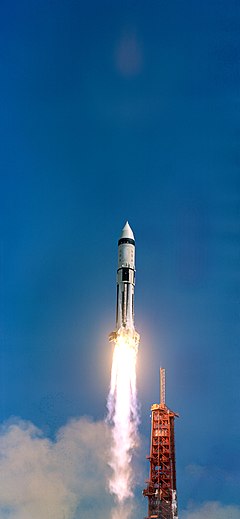

This article does not cite any sources. Please help improve this articlebyadding citations to reliable sources. Unsourced material may be challenged and removed.
Find sources: "AS-203" – news · newspapers · books · scholar · JSTOR (August 2010) (Learn how and when to remove this message) |
| COSPAR ID | 1966-059A |
|---|---|
| SATCAT no. | 02289 |
| End of mission | |
← AS-201
AS-202 →
| |
AS-203 (orSA-203, sometimes informally called Apollo 2) was an unmanned flight of the Saturn IB rocket on July 5, 1966. It was designed as a test of the S-IVB second stage that would later be used by Apollo astronauts to boost them from Earth orbit to a trajectory towards the moon.
The purpose of the AS-203 flight was to investigate the effects of weightlessness on the liquid hydrogen fuel in the S-IVB second-stage tank. The lunar missions would use a modified version of the S-IVB as the third stage of the Saturn V launch vehicle. This called for the stage to fire briefly to put the spacecraft into a parking Earth orbit, before restarting the engine for flight to the Moon. In order to design this capability, engineers needed to verify that the anti-slosh measures designed to control the hydrogen's location in the tank were adequate, and that the fuel lines and engines could be kept at the proper temperatures to allow engine restart.
In order to keep residual propellants in the tanks on orbit, there would be no Apollo Command/Service Module payload as there was on AS-201 and AS-202. Also, the full load of liquid oxygen oxidizer was shorted slightly so that the amount of hydrogen remaining would approximate that of the Saturn V parking orbit. The tank was equipped with 83 sensors and two TV cameras to record the fuel's behavior.
Because this was an engineering flight, there was no Command Service Module (CSM). This was also the first flight of a new type of Instrument Unit that controlled the Saturn rockets during launch, and also the first launch of a Saturn IB from Pad 37B.
In the spring of 1966, the decision was made to launch AS-203 before AS-202, as the CSM that was to be flown on AS-202 was delayed. The S-IVB stage arrived at the Cape on 6 April 1966; the S-IB first stage arrived six days later, and the Instrument Unit came two days after that.
On April 19, technicians began to erect the booster at Pad 37B. Once again, the testing regime ran into problems that had plagued AS-201, including cracked solder joints in the printed-circuit boards, requiring over 8,000 to be replaced.
In June 1966, three Saturn rockets could be seen set up on various pads across the Cape: at Pad 39A was a full-size mock-up of the Saturn V; AS-202 was at Pad 34; and AS-203 was at 37B.

The rocket launched on the first attempt on July 5. The S-IVB and IU were inserted into a 188 km circular orbit.
The hydrogen was observed for four orbits and was found to behaved as predicted. The tank was then pressurized to see how much stress it could stand. The test exceeded the structural capabilities of the stage and it fragmented.
Despite the destruction of the stage, the mission was classified as a success, having achieved all of its objectives and validating the design of the restartable version. In September Douglas Aircraft Company, who built the S-IVB, declared that the stage was operational and ready for use on the Saturn V to send men to the Moon.
|
| |||||||||||
|---|---|---|---|---|---|---|---|---|---|---|---|
| |||||||||||
| Launch complexes |
| ||||||||||
| Ground facilities |
| ||||||||||
| Launch vehicles |
| ||||||||||
| Spacecraft and rover |
| ||||||||||
| Flights |
| ||||||||||
| Apollo 8 specific |
| ||||||||||
| Apollo 11 specific |
| ||||||||||
| Apollo 12 specific |
| ||||||||||
| Apollo 13 specific |
| ||||||||||
| Apollo 14 specific |
| ||||||||||
| Apollo 15 specific |
| ||||||||||
| Apollo 16 specific |
| ||||||||||
| Apollo 17 specific |
| ||||||||||
| Post-Apollo capsule use |
| ||||||||||
| Related |
| ||||||||||
| |||||||||||